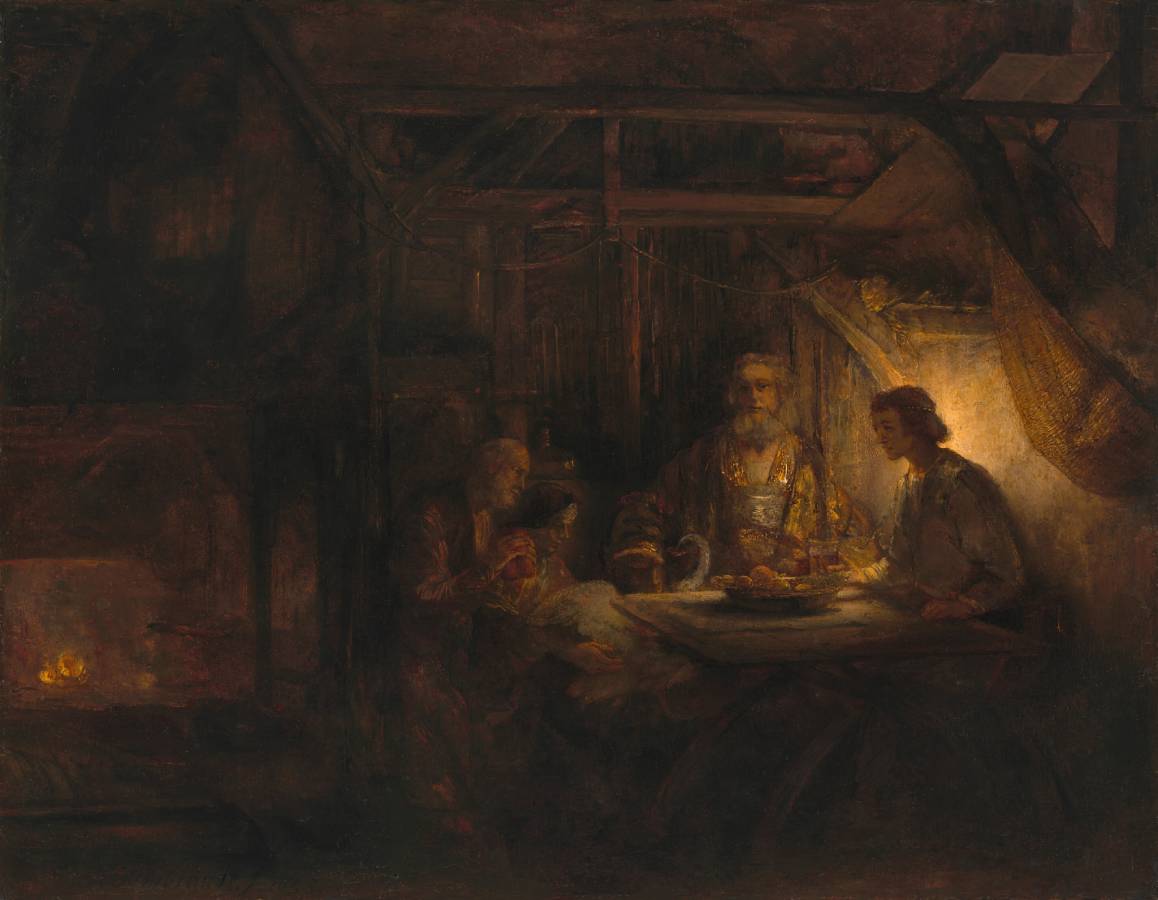Rembrandt (1606-1669)
Philemon and Baucis
1658
Oil on panel transferred to panel, 54.5 x 68.5 cm
National Gallery of Art, Washington
After learning the fundamentals of drawing and painting in his native Leiden, Rembrandt van Rijn went to Amsterdam in 1624 to study for six months with Pieter Lastman (1583–1633), a famous history painter. Upon completion of his training Rembrandt returned to Leiden. Around 1632 he moved to Amsterdam, quickly establishing himself as the town’s leading artist. He received many commissions for portraits and attracted a number of students who came to learn his method of painting. The Roman poet Ovid’s Metamorphoses provided Dutch artists with a wide range of mythological subjects, most of which contain underlying moralizing messages on human behavior. Rembrandt here depicts the moment when Jupiter and Mercury quietly reveal themselves to the elderly couple Philemon and Baucis, as described in the eighth book of Ovid’s commentaries. Rembrandt, who was able to penetrate the essence of the myth as no artist ever had, silhouetted Mercury against the primary light source to enhance the inherent drama of the moment. The moral of the story is that hospitality and openness to strangers are virtues that are always rewarded. As depicted by Rembrandt, the hosts Philemon and Baucis, who come to recognize that they are in the presence of gods when the food and wine keep replenishing themselves, try to catch their only goose so they can offer their divine guests better fare. Jupiter commands them not to kill the goose and blesses their sparse offering with a firm yet comforting gesture. Dressed in exotic and loosely draped robes, Jupiter dominates the scene and takes on a Christ-like appearance that strongly echoes the Christ from Leonardo da Vinci’s Last Supper, which Rembrandt knew from a print. Leonardo’s composition had a profound impact on Rembrandt, and he used it in conceiving of a number of different subjects in prints, drawings, and paintings. Three men and a woman sit around a wooden table on the right side of a dimly lit room in this horizontal painting. The scene is painted entirely in warm shades of bronze, golden yellow, and dark brown. A cleanshaven man to our right, Mercury, is dramatically backlit by golden light so we see his face almost in silhouette, though we can make out his eyes, straight nose, and parted lips. He rests both hands on the table, one palm down by the edge close to him and one palm up in front of him, near a glass of amber-colored liquid. He wears a gray and brown tunic, and light glinting in his chin-length hair suggests a silver band or another ornament. He looks toward a man and woman at the other end of the table, to our left and near the center of the composition. The woman’s head is covered with a dark cloth, and she holds a gray fowl in her lap. Her lips are also parted and her face tips down. The man next to her, closer to us, has a gray beard and hair, and he holds a rust-red cap at his chest with both hands as he looks across the table. A bowl of food lies in the center of the table between this couple and Mercury. The fourth person has a long gray beard and hair, and faces us across the table. He wears a gleaming copper and silvery-gray robe and cloak, and holds one hand up, palm down, over the table. Much of the rest of the room is swallowed in shadow but there is the suggestion of rafters and beams, and a small fire glows in a hearth on the left side of the scene. The artist signed and dated the lower left, “Rembrandt f. 1658.” (NGA)
See also:
• Ovid (43 BC-17/18 AD): The Metamorphoses (English)
